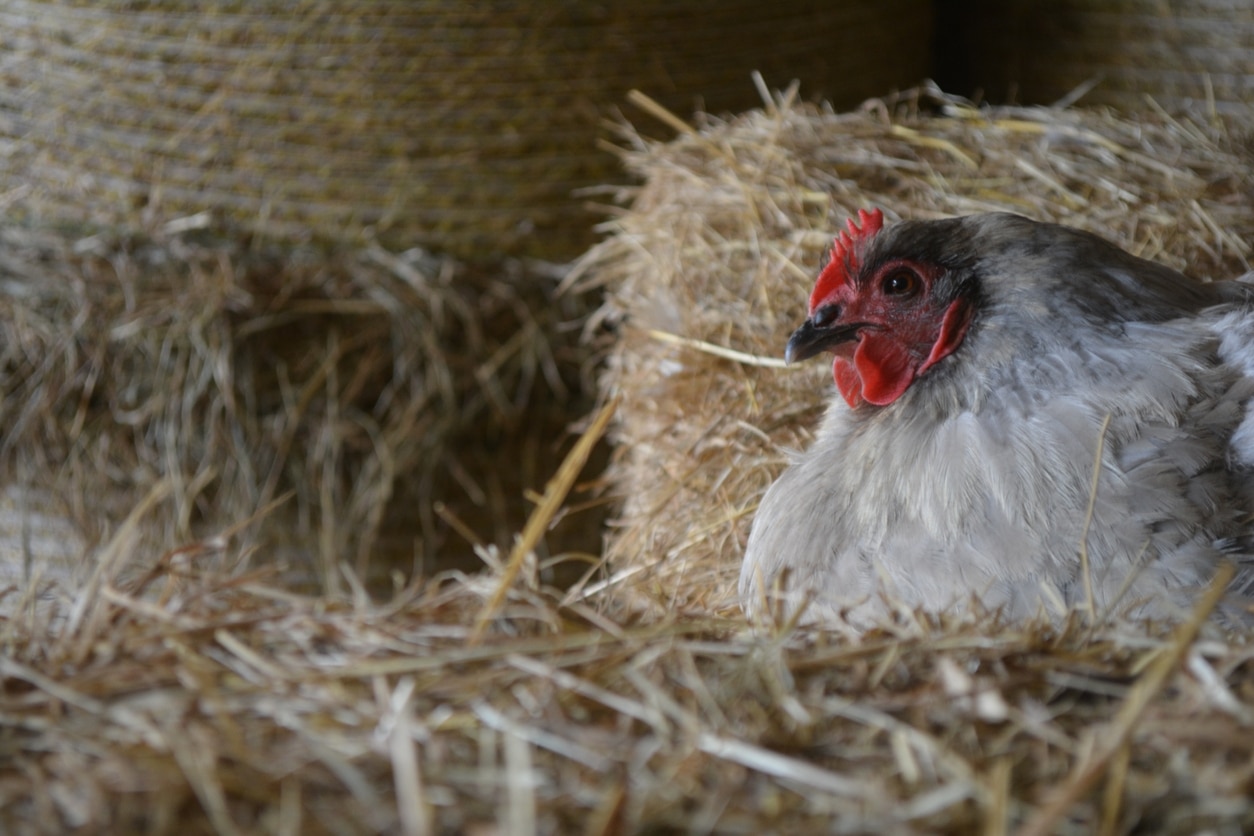Orpington chickens are one of the most popular breeds, but when someone sees a lavender one, they’re instantly mesmerized.
These chickens are much rarer than other birds in the Orpington family, like the Buff Orpington. Yet, beginners should consider adding them to their chicken coop due to their docile temperament and frequent egg production.
[toc]
Lavender Orpington Overview
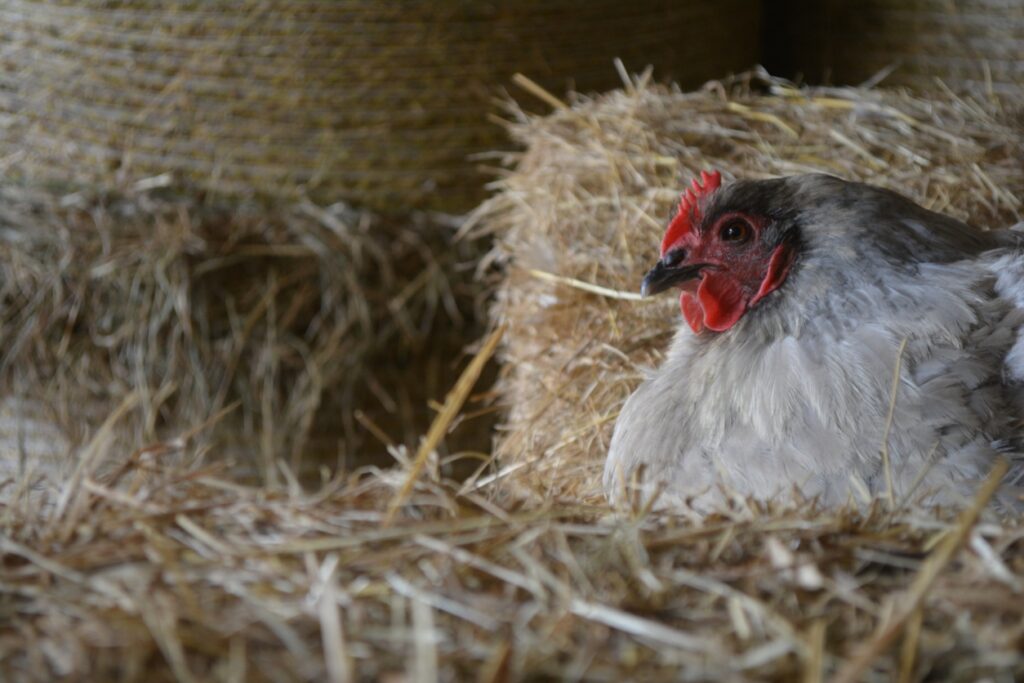
Before we get into the details of these chickens’ personalities and care, let’s take a look at an overview of their traits.
| Lifespan | 5 – 10 years |
| Weight | 7 – 10 pounds |
| Appearance | Lavender feathers |
| Egg Production | 3-4 per week, about 200 per year |
| Egg Color | Light brown eggs |
| Good for Beginners? | Yes |
| Minimum Habitat Size | 2 – 3 square feet per bird, but 8 – 10 per bird is ideal. |
| Price | $10 – $45 per chick |
Lavender Orpington Chicken History
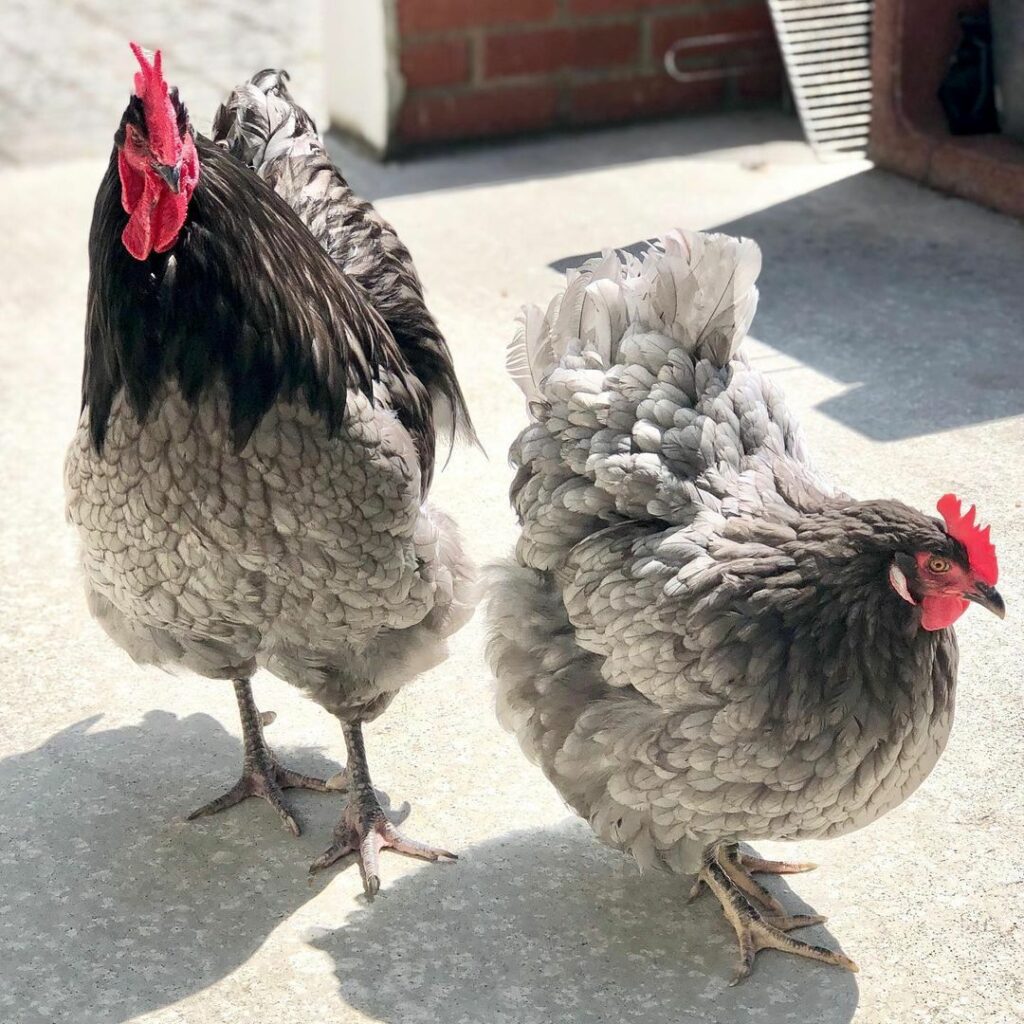
A man named William Cook bred the first Orpington chickens during the 1800s, in a small town in England named Orpington. They were bred for two purposes: eggs and meat.
The first Orpington chicken had black feathers. Its body was large, and it had great egg-laying abilities. Cook brought his prized Orpingtons to poultry shows in the United States, where they instantly gained popularity.
Soon after, other colors of Orpington chickens were created, including white, red, buff, and eventually lavender. Lavender chickens are the most modern Orpington variant, but they’re the easiest to spot due to their uniquely colored feathers.
Here are Some Types of Orpingtons:
- Buff
- Lavender
- White
- Black
- Blue
- Cuckoo
- Spangled
- Partridge
Sometimes, Lavender Orpington chickens are also referred to as Self-Blue Orpingtons. The lavender gene isn’t one of the most common options, which is why many people desire that variant.
Lavender Orpington Appearance
Lavender Orpington chickens have a recognizable, desirable appearance. They look similar to Buff Orpingtons, only with a beautiful lavender color.
What Color Eggs Do Lavender Orpingtons Lay?
The Lavender Orpington egg color is light brown. The light brown eggs are fairly large, and female chickens lay about three to four eggs per week.
If you want a wider variety of egg colors, consider getting a hen that lays colored eggs instead.
Chick Appearance
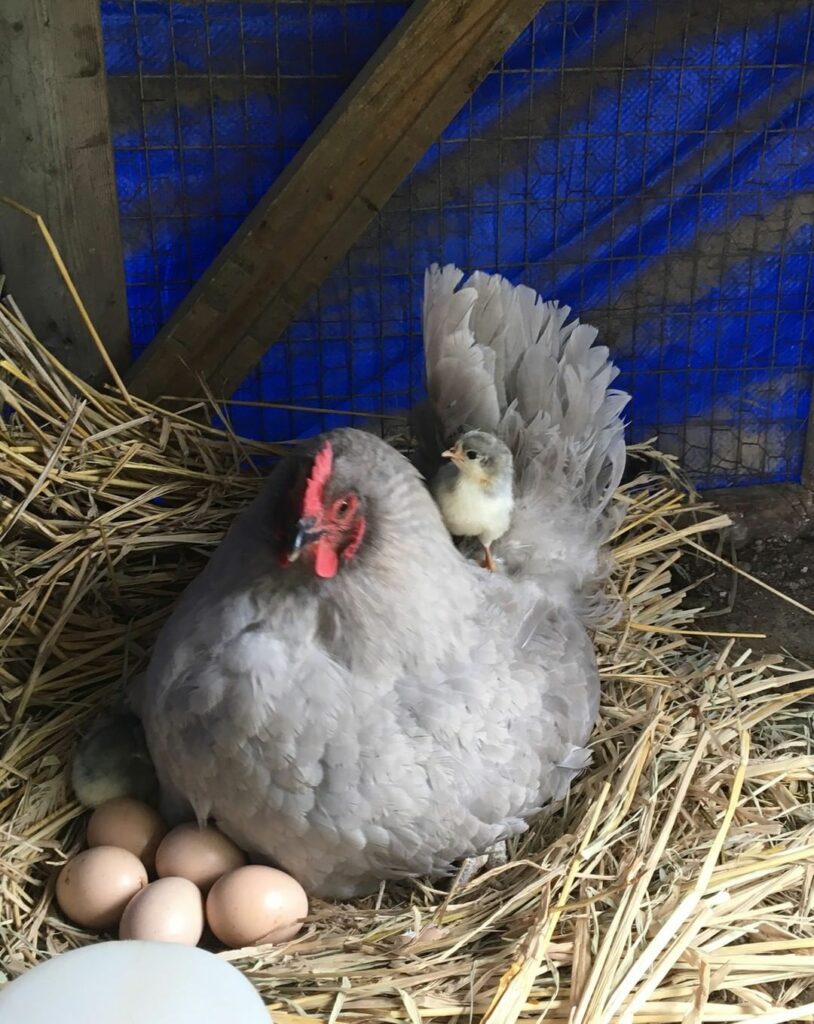
Lavender Orpington chicks aren’t born with this breed’s signature color. Instead, they’re usually a pale yellow like most baby chicks, but with hints of gray and lavender in their feathers. They’re soft and fuzzy with black beaks.
Then, Lavender Orpington pullets look similar to the adults, only smaller. At that age, they start to develop faint Lavender feathers and a small comb. Lavender Orpington pullets can usually be moved into a larger enclosure so they can interact with adult chickens.
Adult Appearance
Adults are big chickens, with hens weighing about 8 pounds and roosters weighing 10 pounds. Their lavender feathers look fluffy, making them look bigger than they actually are. Yet, Lavender Orpington chickens don’t feel as soft as you’d expect.
They have a red comb with five points, and their wattles and earlobes are also red. Their eyes are a dark red-brown color, and they always have dark-colored beaks.
Breed Standard
Lavender isn’t a color that’s officially recognized in the United States or the United Kingdom. Yet, due to their increasing popularity, they might be recognized in the near future.
The general Orpington breed standard states that they should be broad-bodied and low to the ground. Their backs should be short and curved, while their tails are also fairly short.
Lavender Orpington Temperament
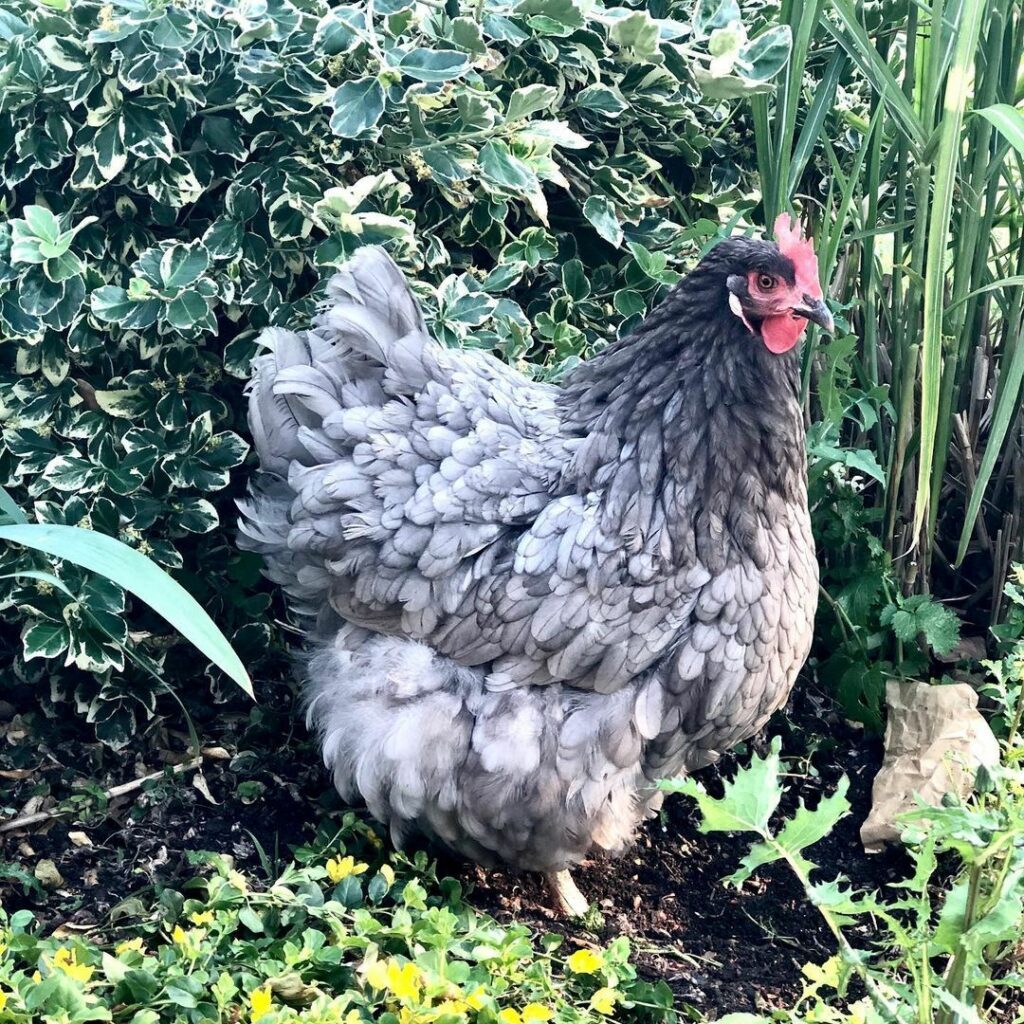
Orpington chickens are a non aggressive breed that’s known for being docile and friendly. Some consider them the “Golden Retrievers” of chickens because they’re one of the friendliest breeds. If they’re raised as chicks, they will learn to come when called, cuddle with humans, and even learn some tricks for treats.
Yet, when you first get a Lavender Orpington, they might seem more reserved. They can be shy around strangers, but the more time they spend around you, the more their personalities will show. While they can get along with kids, make sure small children are cautious around them at first.
However, hens are much friendlier than roosters. Lavender Orpington roosters tend to be territorial, even if they’re the only one in the enclosure. Lavender Orpington chickens with aggression can be trained and socialized to make them more easygoing, but some keepers prefer to not have any roosters instead.
In general, Lavender Orpington chickens are quiet and rarely make noise, making them one of the quietest chicken breeds. They may make sounds to communicate with each other, but for the most part, they won’t disturb your neighbors.
Broodiness
“Broody” refers to when a hen’s motherly instincts kick in, and she instinctively wants to protect her eggs. Lavender Orpington hens are known to be fairly broody, which has its pros and cons.
These hens act broody around two times a year. They make great mothers, so if you need to hatch certain eggs, you can keep them near your Orpington hens, and they will likely protect them.
However, some people don’t want their chickens to be broody since it could cause some aggression. Broody hens are determined to protect their eggs and baby chicks, so if that overwhelms you, then they’re probably not the right chickens for you.
Housing with Other Birds
Yes, the Orpington breed gets along with just about every creature they meet. Not only are they friendly around humans, but they also get along with horses, cows, sheep, and goats. Each Lavender Orpington chicken will have their own temperament and personality, but for the most part, they’ll be calm and easygoing no matter what animals they’re around.
However, since Orpingtons are docile birds, it’s common for them to be bullied by other animals. If you have any aggressive animals on your property, be sure to keep them separated from your Orpingtons.
The best chickens to live with Orpingtons are:
- Speckled Sussex
- Barred Rock
- Brahma
- Cochin
Care Requirements
While Lavender is a rare chicken color, these birds are easy chickens for beginners. They don’t need too much space, and they’re resilient to various weather conditions. Plus, their friendly nature only makes them easier to work with.
Diet
Lavender Orpington chickens aren’t picky, but you’ll need to be the most careful when they’re young. Lavender Orpington chicks need to eat a high protein crumble until they’re at least 16 weeks old. That food should have at least 20% protein.
Then, you can give your adult chickens a balanced diet with more variety. Many keepers give their chickens a mix of pellets and grains. Adult chickens may also forage for plants and seeds, even when provided with food. They might eat grass, weeds, slugs, and worms.
Luckily, most of the foods your chickens snack on are safe for them. However, avoid items like garlic, onions, beans, and citrus because they can make the chicken’s eggs taste odd. Also, raw potatoes are toxic to Orpington chickens, so avoid serving that at all costs.
It’s okay to leave chicken food out without monitoring it. They may overeat, but it won’t affect their health unless it’s excessive. Most keepers provide food for their chickens in the morning so they have time to roam around and gain all their nutrients right away.
Habitat Setup
When keeping any animals, it’s important to give them more than enough space. Some sources suggest that these birds only need 2 to 3 square feet per bird, but Orpingtons are large birds, so 8 to 10 square feet per bird is ideal. If there are aggressive birds in the mix, more space is essential.
In their chicken coop, you must provide an area where they can retreat to during inclement weather. It should stay dry during storms and block out wind on colder days.
Roosting spaces are also important for Orpingtons. Since they’re large chickens, they should each get 10 to 12 inches of space on the perch. Keep the perches low to the ground so your chickens won’t injure themselves when they jump down.
In addition to their chicken coop area, your Orpingtons should also have additional room to roam. Each Lavender Orpington chicken should have 10 to 12 square feet of space in their roaming area. Since they can’t fly far, you don’t need anything taller than a three-foot fence to contain them.
Throughout your chickens’ coop and roaming space, they should have objects to keep them busy and entertained. Piles of leaves and cabbage piñatas are great objects for chickens to interact with.
Some chicken keepers choose to keep their chicken coop in a trailer so they can move it around and change the area that the chickens roam around in. This can give them new areas to forage. Giving chickens some free-range is good for foraging, but can put them more at risk of predators.
Temperature
Lavender Orpington chickens can do well in all types of weather conditions, from 0 to 100 degrees Fahrenheit. However, since they have thick layers of feathers, they prefer cold weather over hot weather. Their feathers allow them to stay warm in the winter.
The only time the cold is a major concern is if the chickens get wet. Wet feathers prevent them from keeping warm in frigid temperatures, so make sure you dry them off thoroughly as needed.
In the summer, Lavender Orpington chickens can get hot too quickly if left in the sun. Provide them with shade, dust baths, and cool water so they can cool themselves off as needed. Too much sunlight not only leads to overheating, but it could also cause their lavender feathers to fade, making them look more yellow or tan.
How to Breed Orpingtons
Lavender Orpington hens will continue to produce eggs on their own, but they won’t turn into chicks unless a rooster is present. These Lavender Orpington eggs are great for food, but if you want to breed more chickens, you’ll need to introduce a Lavender Orpington rooster to the coop.
Hens lay the most fertilized eggs in the spring. So, that’s the best time to have a rooster around. You don’t need to intervene in any way since the rooster will handle it. Roosters approach hens by dancing for them in an attempt to win them over. Then, when a hen and rooster mate, you’ll get fertilized eggs that will hatch into chicks.
Egg Production
If you want chickens to produce eggs for food, then Lavender Orpington chickens are an excellent chicken breed for that. Hens produce about three to four eggs per week, which means one chicken can create about 200 eggs per year. They’re a great chicken for producing eggs consistently.
If you’re unsure what to do with your chicken eggs, try out different fresh egg recipes.
How to Breed the Lavender Color
Lavender is a recessive gene in chickens. So, to get a Lavender Orpington, both parents must be carrying the lavender gene. Breeding two unrelated Orpingtons with lavender feathers will likely give you a Lavender Orpington chick.
Unfortunately, the lavender gene might be related to abnormal feather growth in chickens. So, be cautious of that when breeding your chickens. If you purchase your chickens from a different breeder, make sure you go to someone reputable to avoid these common breeding issues.
Lavender Orpington Health Concerns
Luckily, these chickens aren’t difficult to keep in shape. Yet, like all animals, they’re susceptible to some health concerns and diseases.
The most common health problem that Lavender Orpingtons face is obesity. They can be lazy and love to hang out near their feeders as much as possible. If your chickens seem to be gaining weight rapidly, reconsider what they’re eating and find ways to keep them busier and more active.
It’s also possible for Lavender Orpingtons to get infestations, including lice, mites, and worms. These occur most often under the chickens’ wings. Providing a dust bath for them is an easy way for them to keep themselves clean and healthy. You can also provide them with treatments to avoid infestations altogether.
If you set up the perches in your chicken coop too high, your Lavender Orpingtons could easily hurt their legs. They’re large birds that can’t fly far, so try to avoid putting areas in their coop that they could fall from.
Overall, Lavender Orpingtons are a healthy chicken breed with no genetic concerns. Most of their health risks are the same ones you would face with any other chicken breeds.
Keeping Your Chickens Healthy
If one Lavender Orpington chicken in your coop catches a disease, it’s likely that the rest will get it too. So, keeping the living conditions of your Lavender Orpington chickens clean is the key to keeping them healthy overall. Refill their food and water regularly and clean other spaces as needed.
Giving the chickens plenty of space to roam can also prevent them from getting sick. Too many chickens in a small space will make them not as healthy and happy as they could be. Also, avoid getting their chicken coop wet. Too much water could cause unhealthy bacteria to build up in their space.
While it’s not a health problem, it’s important to keep your chickens safe from predators too. Foxes, coyotes, and bobcats will scoop up chickens if given the chance. Make sure your chickens are safely secured at night to prevent a wild animal from making them into a snack.
How Much Do Lavender Orpingtons Cost?
Lavender Orpingtons are a bit more expensive than your typical chick since they’re more uncommon. Females can cost anywhere from $10 to $45 per chick.
Yet, males are often more affordable, sometimes costing as little as $5 per chick. Like most chicken breeds, you can get a discount if you buy large quantities of baby chicks at once.
Frequently Asked Questions
You can never have too much information when preparing to get a chicken. So, here are some questions that new chicken keepers commonly ask.
When Do Lavender Orpingtons Start Laying?
Like other Orpington breeds, Lavender Orpingtons start laying eggs between 5 and 7 months old. After that, they consistently lay 3 to 4 eggs every week.
How Do You Sex Lavender Orpington Chicks?
Lavender Orpington chicks have the same color feathers regardless of their sex. The easiest way to tell them apart is by looking at their tails. Male chicks usually have long tails while females do not have much of a tail.
Males might have pale streaks near the upper joints of their wings while females often have pale lines on their backs. Females might also have a brown spot on their heads.
Are Lavender Orpington Roosters Aggressive?
Orpington roosters are less aggressive than other rooster breeds. They’re great at protecting your property, but they rarely harm humans or other birds. If you’re worried about rooster aggression, be cautious when choosing the right rooster.
Are Lavender Orpingtons Rare?
Yes, Lavender Orpingtons are rare. The lavender coloring is recessive, so it’s much less common than other Orpington variants. Despite their rarity, they’re a popular breed due to their friendly personalities and reliable egg laying.
Should You Raise a Lavender Orpington?
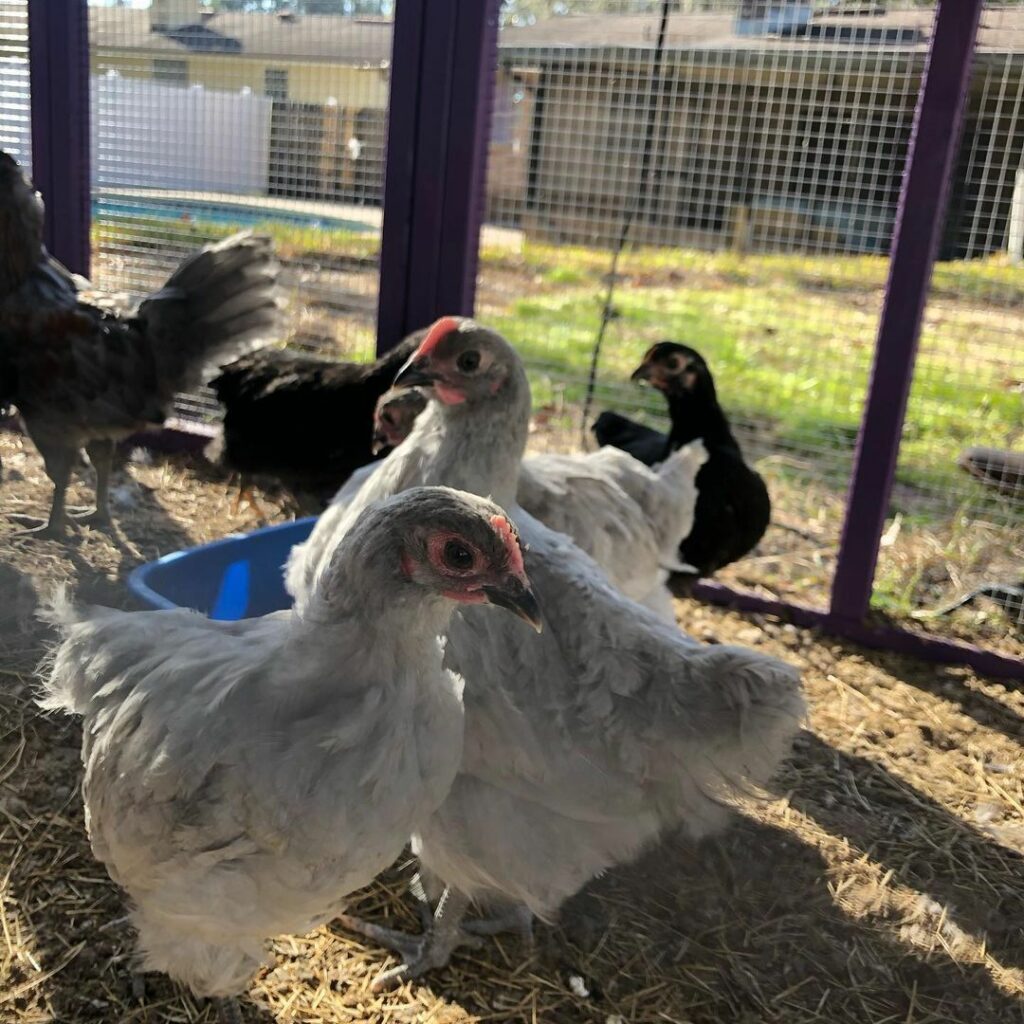
Lavender Orpingtons are easy chickens to care for, but you still need to be prepared before welcoming them into your space. If you’re looking for a chicken that can produce a lot of eggs per year, a Lavender Orpington might be the right choice for you.
Many people also choose Lavender Orpington chickens due to their friendly nature and adaptability. Before purchasing a Lavender Orpington, make sure you have more than enough space for them to roam, along with enough resources to provide them with basic needs.
If you have trouble finding a reputable Lavender Orpington breeder, there are plenty of other types of Orpington chickens that will be just as suitable. The main difference is the color of their feathers, which doesn’t affect their care requirements and egg production.
So, as long as you’re prepared to care for more living creatures, then raising Lavender Orpingtons will likely be a great addition to your household.
